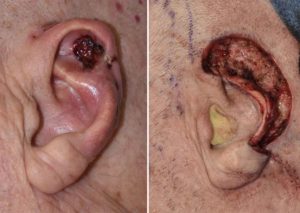Background: Ear reconstruction is most commonly done using autologous graft materials. Whether it is microtia reconstruction using rib cartilage in children or adult ear reconstruction using cartilage grafts and pedicled skin flaps, the patient’ own tissues offer the least risk of postoperative complications and should be done when possible.
The use of synthetic frameworks or implants for ear reconstruction has its origin and current use with Medpor material. Most commonly done as an alternative to the use of rib cartilage in congenital microtia deformities in children, it offers a premade and well shaped ear implant. As a substitute for a hand-carved rib cartilage ear framework, it requires vasculrized tissue cover using the temporalis fascial flap (TPF flap) covered with a split-thickness skin graft. Its benefits is that it usually creates a much better shaped ear in the end and does so in less operative time with no need for a rib graft donor site.
While Medpor ear frameworks are effective, the material itself does not replicate very well the physical characteristics of natural ear cartilage. It is much more stiff (in fact rigid) and lacks any substantial flexibility. While creating a nice ear shape it does not create a good feeling ear. This stiffness can make the Medpor framework ear prone to occasional discomfort and skin breakdown due to pressure or trauma.



With healing time and tissue contraction, the details of the ear framework will eventually become more apparent through the applied vascular cover. In the long run the reconstructed ear will have a more natural feel due to the inherent softness of the ePTFE material.
Highlights:
- Synthetic ear reconstruction relies on the use of a Medpor ear framework covered by a fascial flap and skin graft.
- A new synthetic ear implant made of a composite silicone and ePTFE coating offers a softer and more flexible design.
- Composite ePTFE ear frameworks offer a carving feel that is identical to that of natural rib.
Dr. Barry Eppley
Indianapolis, Indiana




